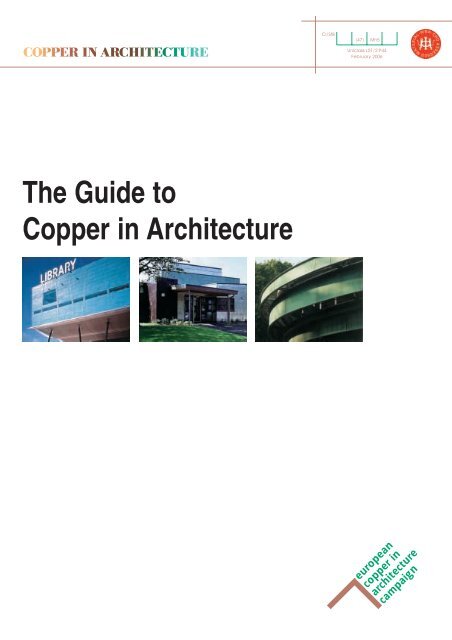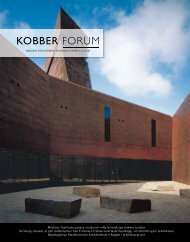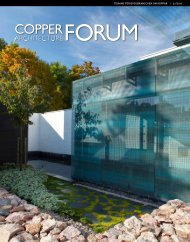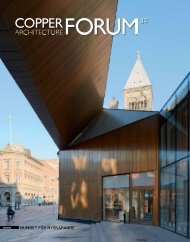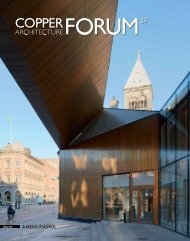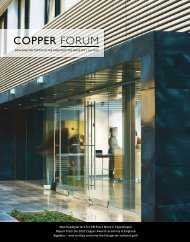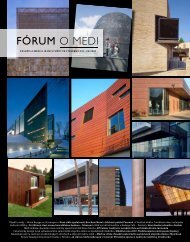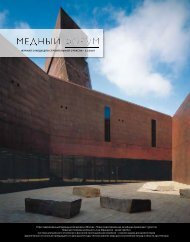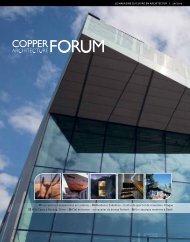The Guide to Copper in Architecture - Copper Concept
The Guide to Copper in Architecture - Copper Concept
The Guide to Copper in Architecture - Copper Concept
Create successful ePaper yourself
Turn your PDF publications into a flip-book with our unique Google optimized e-Paper software.
<strong>The</strong> <strong>Guide</strong> <strong>to</strong><br />
<strong>Copper</strong> <strong>in</strong> <strong>Architecture</strong><br />
CI/SfB<br />
(47) Mh5<br />
Uniclass L51/2:P44<br />
February 2006<br />
european<br />
copper <strong>in</strong><br />
architecture<br />
campaign
1<br />
INTRODUCTION<br />
This <strong>Guide</strong> is <strong>in</strong>tended <strong>to</strong> give an <strong>in</strong>troduc<strong>to</strong>ry<br />
background <strong>to</strong> copper as the roof<strong>in</strong>g and cladd<strong>in</strong>g<br />
material for the future <strong>in</strong> the UK. For further<br />
<strong>in</strong>formation on specific <strong>to</strong>pics visit the website<br />
www.cda.org/arch.<br />
COPPER…<br />
a pure, natural material used for centuries as an<br />
effective roof cover<strong>in</strong>g, with the added attraction of<br />
unique, chang<strong>in</strong>g visual characteristics. Offer<strong>in</strong>g an<br />
effectively <strong>in</strong>def<strong>in</strong>ite design life, it is extremely durable<br />
and resistant <strong>to</strong> corrosion <strong>in</strong> any atmosphere,<br />
requir<strong>in</strong>g no decoration, ma<strong>in</strong>tenance or clean<strong>in</strong>g.<br />
<strong>Copper</strong> is environmentally friendly, fully recyclable,<br />
safe <strong>to</strong> use and can be worked at all temperatures.<br />
THE PAST…<br />
<strong>Copper</strong> was one of the first metals used<br />
by man. His<strong>to</strong>rically, the use of copper<br />
can be traced back over 10,000 years,<br />
through archaeological f<strong>in</strong>ds of copper<br />
weapons, jewellery and household<br />
goods. Evidence of early metal work<strong>in</strong>g<br />
and ref<strong>in</strong><strong>in</strong>g sites have been discovered<br />
<strong>in</strong> many places, <strong>in</strong>clud<strong>in</strong>g the Middle<br />
East, Africa and Ch<strong>in</strong>a.<br />
<strong>The</strong> Ancient Egyptians m<strong>in</strong>ed for copper<br />
over 4,000 years ago and the Romans<br />
used copper from m<strong>in</strong>es <strong>in</strong> Brita<strong>in</strong>.<br />
Many of the great churches of medieval<br />
Europe were roofed <strong>in</strong> the material.<br />
Indeed, a 13th century copper church<br />
roof <strong>in</strong> Germany survives <strong>in</strong>tact <strong>to</strong> this<br />
day. <strong>Copper</strong>’s dist<strong>in</strong>ctive green pat<strong>in</strong>a<br />
plays a major part <strong>in</strong> the skyl<strong>in</strong>es of most<br />
Hildersheim Cathedral, 1280.<br />
European cities. Tried and tested fix<strong>in</strong>g<br />
details and techniques make copper the<br />
most trouble-free material for roof<strong>in</strong>g, cladd<strong>in</strong>g,<br />
flash<strong>in</strong>gs, gutters, downpipes and other details.<br />
…PRESENT…<br />
Not that copper technology has s<strong>to</strong>od still. Cladd<strong>in</strong>g<br />
copper <strong>to</strong>day is more pure than <strong>in</strong> the past, ensur<strong>in</strong>g<br />
consistent performance as a thoroughly modern<br />
build<strong>in</strong>g material. Advances <strong>in</strong> prefabrication,<br />
<strong>to</strong>gether with <strong>in</strong>-situ mach<strong>in</strong>e form<strong>in</strong>g, mechanised<br />
seam<strong>in</strong>g and fix<strong>in</strong>g technology have greatly<br />
improved productivity. <strong>The</strong> substantially lower costs<br />
result<strong>in</strong>g from these modern techniques now allow<br />
copper <strong>to</strong> be used on a much wider variety of<br />
build<strong>in</strong>g types than <strong>in</strong> the past.<br />
Hounslow East Station, London. Architect: Acanthus Lawrence<br />
& Wrightson. <strong>Copper</strong> Contrac<strong>to</strong>r: Brodericks.<br />
Architects <strong>to</strong>day are tak<strong>in</strong>g advantage of the<br />
flexibility of copper as a dist<strong>in</strong>ctive external cover<strong>in</strong>g<br />
for any build<strong>in</strong>g element <strong>in</strong>clud<strong>in</strong>g all roof slopes,<br />
cladd<strong>in</strong>g, soffits, fascias, flash<strong>in</strong>gs, gutters and down<br />
-pipes.<br />
…AND FUTURE<br />
<strong>Copper</strong> alloy mesh cladd<strong>in</strong>g at Plymouth <strong>The</strong>atre Royal Production Centre. Architect: Ian Ritchie Architects.<br />
<strong>Copper</strong> Contrac<strong>to</strong>rs: Lockerwire Weavers/Rubb TM.<br />
With the grow<strong>in</strong>g awareness of susta<strong>in</strong>ability and<br />
<strong>in</strong>creas<strong>in</strong>g concern for the health and safety of<br />
those construct<strong>in</strong>g and ma<strong>in</strong>ta<strong>in</strong><strong>in</strong>g our build<strong>in</strong>gs,<br />
copper is more than ever the cost-effective,<br />
adaptable roof<strong>in</strong>g and cladd<strong>in</strong>g material of the<br />
future.<br />
A museum at the University of Pennsylvania<br />
displays a copper fry<strong>in</strong>g pan that has been<br />
dated <strong>to</strong> be more than 50 centuries old.
SOURCES<br />
Most copper is produced from open-cast m<strong>in</strong>es and<br />
reserves are plentiful with deposits worked <strong>in</strong> all five<br />
cont<strong>in</strong>ents.<strong>The</strong> copper is extracted from vast volumes<br />
of ore, ma<strong>in</strong>ly copper sulphides, by smelt<strong>in</strong>g - and<br />
then ref<strong>in</strong>ed by electrolysis <strong>in</strong> huge tank houses.<br />
At the start of the 18th century, about 90% of the<br />
world output of copper was smelted <strong>in</strong> South Wales,<br />
although <strong>to</strong>day most copper ref<strong>in</strong><strong>in</strong>g is carried out<br />
close <strong>to</strong> the ma<strong>in</strong> sources of ore <strong>in</strong> different parts of<br />
the world.<br />
2 Newhams Row, London. Architect: Glas Architects and<br />
Designers. <strong>Copper</strong> Contrac<strong>to</strong>r: Metalex.<br />
A substantial proportion of the world’s demand<br />
for copper is currently provided from recycled<br />
copper scrap, a practice which has been<br />
established for many years. Even the ancient<br />
copper roof cover<strong>in</strong>g of the Royal Palace <strong>in</strong><br />
S<strong>to</strong>ckholm (removed because of a failed substrate)<br />
was recycled <strong>in</strong> the form of commemorative co<strong>in</strong>s.<br />
Consumption, Reserves and Recycl<strong>in</strong>g of copper are<br />
dealt with <strong>in</strong> more detail on page 6 and on the<br />
website www.cda.org/arch.<br />
JLE Vent Shafts, London. Architect: Ian Ritchie Architects. <strong>Copper</strong> Contrac<strong>to</strong>r: Entech.<br />
Peckham Library. Architect: Alsop and S<strong>to</strong>rmer Architects.<br />
<strong>Copper</strong> Contrac<strong>to</strong>r: Cleveco.<br />
Brewery Square, London. Architect: Hamil<strong>to</strong>n Associates<br />
Architects. <strong>Copper</strong> Contrac<strong>to</strong>r: Brodericks/CGL Systems.<br />
We’re <strong>in</strong> no danger of runn<strong>in</strong>g out of copper:<br />
known world-wide resources are estimated at<br />
nearly 5.8 trillion pounds of which only 12%<br />
have been m<strong>in</strong>ed throughout his<strong>to</strong>ry and most<br />
of that is still <strong>in</strong> use <strong>to</strong>day.<br />
2
3<br />
PROPERTIES<br />
COPPER<br />
Mews houses, Dubl<strong>in</strong>.<br />
Architect: de Blacam and<br />
Meagher. <strong>Copper</strong> Contrac<strong>to</strong>r:<br />
Misk<strong>in</strong> Services.<br />
Periodic symbol: Cu.<br />
Density: 8930kg/m3 .<br />
Melt<strong>in</strong>g po<strong>in</strong>t: 1083˚C.<br />
<strong>The</strong>rmal expansion: 0.0168mm/m/˚C (20-100˚).<br />
Tensile strength: 210 - 240 N/mm2 (soft - half hard).<br />
COPPER FOR ROOFING AND<br />
CLADDING<br />
Phosphorus deoxidised non-arsenical copper is used<br />
with the designation C106. <strong>The</strong> copper is rolled <strong>to</strong><br />
thicknesses rang<strong>in</strong>g between 0.5 and 1.0mm<br />
(1.5 - 3.0mm for curta<strong>in</strong> wall<strong>in</strong>g) but a 0.6 - 0.7mm<br />
thickness is usually used for roof<strong>in</strong>g.<br />
Allow<strong>in</strong>g for seam<strong>in</strong>g, 1m2 of copper roof<br />
weighs approximately 6.5kg.<br />
<strong>Copper</strong> can be worked at any<br />
temperature and does not become<br />
brittle <strong>in</strong> cold weather. It is available <strong>in</strong><br />
sheets or strips and is generally regarded<br />
as a lightweight cover<strong>in</strong>g requir<strong>in</strong>g a<br />
support<strong>in</strong>g substrate (such as 25mm<br />
board<strong>in</strong>g), although thicker, selfsupport<strong>in</strong>g<br />
copper panels are used for<br />
cladd<strong>in</strong>g. <strong>Copper</strong> is also available <strong>in</strong><br />
prefabricated rolled profiles, flash<strong>in</strong>gs,<br />
sh<strong>in</strong>gles, gutters and downpipes.<br />
Suitable pitches range from 5˚ (or less <strong>in</strong><br />
special circumstances) <strong>to</strong> 90˚ and even<br />
negative pitches (such as bell section<br />
soffits) are easily handled. “Temper”, or<br />
the malleability of copper sheet, ranges<br />
from “soft” <strong>to</strong> “half hard” depend<strong>in</strong>g<br />
upon application.<br />
CHARACTERISTICS<br />
LIGHTWEIGHT<br />
Archaeologists found 5,000 year<br />
old copper tub<strong>in</strong>g <strong>in</strong> serviceable<br />
condition at the Pyramid of<br />
Cheops <strong>in</strong> Egypt.<br />
<strong>Copper</strong> when used as a fully supported roof<br />
cover<strong>in</strong>g is half the weight (<strong>in</strong>clud<strong>in</strong>g substrate) of<br />
lead and only a quarter of tiled roofs, with<br />
consequent sav<strong>in</strong>gs <strong>in</strong> support<strong>in</strong>g structure and<br />
materials generally.<br />
LOW THERMAL MOVEMENT<br />
With a thermal expansion value 40% less than both<br />
z<strong>in</strong>c and lead, properly designed copper roofs<br />
m<strong>in</strong>imise movements due <strong>to</strong> thermal changes,<br />
avoid<strong>in</strong>g deterioration and failure. In addition, the<br />
high melt<strong>in</strong>g po<strong>in</strong>t of copper ensures that it will not<br />
“creep” or stretch as some other metals do.<br />
INDEFINITE LIFE<br />
<strong>Copper</strong> roofs have been known <strong>to</strong> perform well for<br />
over 700 years and it is <strong>in</strong>variably substrates - not the<br />
copper itself - which eventually fail.<br />
Renovation of <strong>to</strong>p dome, Bank of Scotland HQ,<br />
Ed<strong>in</strong>burgh. Roof<strong>in</strong>g Contrac<strong>to</strong>r: D. Blake & Co.<br />
NO MAINTENANCE<br />
<strong>Copper</strong> does not require any decoration, clean<strong>in</strong>g<br />
or ma<strong>in</strong>tenance. It is therefore particularly suited for<br />
areas which are difficult or dangerous <strong>to</strong> access<br />
after completion.<br />
DURABLE<br />
<strong>Copper</strong> exposed <strong>to</strong> the outside protects itself<br />
by develop<strong>in</strong>g a pat<strong>in</strong>a over time, which can<br />
reform if damaged, ensur<strong>in</strong>g extreme durability<br />
and resistance <strong>to</strong> corrosion <strong>in</strong> virtually any<br />
atmosphere. Unlike some other metals, copper<br />
does not suffer from underside corrosion.
Hous<strong>in</strong>g association terraced hous<strong>in</strong>g, Sut<strong>to</strong>n.<br />
Architect: ECD Partnership.<br />
COST-EFFECTIVE<br />
With its <strong>in</strong>def<strong>in</strong>ite life and unique visual<br />
characteristics, copper roof<strong>in</strong>g is often found<br />
on prestigious build<strong>in</strong>gs and might be perceived as<br />
a “premium” material. However, recent <strong>in</strong>dependent<br />
research has shown that, because of light weight<br />
and other benefits, copper roofs are comparable<br />
with z<strong>in</strong>c, sta<strong>in</strong>less steel, alum<strong>in</strong>ium and even some<br />
clay and concrete tiles when consider<strong>in</strong>g overall<br />
roof<strong>in</strong>g costs (<strong>in</strong>clud<strong>in</strong>g structure). <strong>Copper</strong> roof<strong>in</strong>g is<br />
considerably less expensive than lead,Welsh slate or<br />
hand made clay tiles.<br />
DHSS Labora<strong>to</strong>ries at Colera<strong>in</strong>e, Northern Ireland.<br />
Architect: Todd Architects and Planners.<br />
Roof<strong>in</strong>g Contrac<strong>to</strong>r: Edgel<strong>in</strong>e Contracts.<br />
Us<strong>in</strong>g life cycle cost<strong>in</strong>gs, the research also reveals<br />
copper as a more cost-effective material than<br />
virtually any other for roofs with a 30 year or greater<br />
life, due <strong>to</strong> its durability, ma<strong>in</strong>tenance free nature<br />
and ultimate salvage value. With the grow<strong>in</strong>g<br />
<strong>in</strong>terest <strong>in</strong> copper roof<strong>in</strong>g by build<strong>in</strong>g designers,<br />
contrac<strong>to</strong>rs are becom<strong>in</strong>g <strong>in</strong>creas<strong>in</strong>gly familiar with<br />
prefabrication, mechanised seam<strong>in</strong>g and other<br />
cost sav<strong>in</strong>g techniques. <strong>The</strong> cost competitiveness of<br />
copper is result<strong>in</strong>g <strong>in</strong> its use on a much wider variety<br />
of build<strong>in</strong>g types than <strong>in</strong> the past - not just on<br />
prestigious projects.<br />
Multi-s<strong>to</strong>rey car park, Caernarfon.<br />
Designers: Adams Consult<strong>in</strong>g Eng<strong>in</strong>eers.<br />
Roof<strong>in</strong>g Contrac<strong>to</strong>r: Varla (UK).<br />
LEADEN HALL SCHOOL,<br />
CLOSE TO SALISBURY CATHEDRAL<br />
“To have used any material other than copper would have made it<br />
impossible <strong>to</strong> achieve this build<strong>in</strong>g economically with the lightness<br />
of <strong>to</strong>uch and elegance of detail<strong>in</strong>g required. <strong>The</strong> choice of copper<br />
was acknowledged by English Heritage, CABE and the Cathedrals<br />
Fabric Commission, and helped greatly with obta<strong>in</strong><strong>in</strong>g plann<strong>in</strong>g<br />
and listed build<strong>in</strong>g consent on this sensitive site, with wide public<br />
support. <strong>The</strong> cost-effectiveness of copper was also essential <strong>to</strong> the<br />
affordability of the project.” Keith Harnden, Architect.<br />
Architect: Keith Harnden.<br />
A document entitled ‘Compar<strong>in</strong>g Costs’,<br />
summaris<strong>in</strong>g the research by Davis Langdon &<br />
Everest, is available from <strong>Copper</strong> <strong>in</strong> <strong>Architecture</strong>.<br />
<strong>The</strong> Crown Street Regeneration Project, Gorbals, Glasgow.<br />
Architect: Hypostyle.<br />
Roof<strong>in</strong>g Contrac<strong>to</strong>r: A & J Roof<strong>in</strong>g Specialists.<br />
4
5<br />
SUSTAINABILITY<br />
‘Susta<strong>in</strong>ability’ is a widely used description <strong>to</strong>day<br />
which still rema<strong>in</strong>s difficult <strong>to</strong> def<strong>in</strong>e or apply useful<br />
quantitative measures <strong>to</strong>. However, by any<br />
standards copper has impeccable environmental<br />
credentials and is well-used by architects with long<br />
experience of susta<strong>in</strong>able construction, as shown<br />
later. <strong>The</strong> follow<strong>in</strong>g pages address the major issues<br />
but research <strong>in</strong> this field cont<strong>in</strong>ues and the most up<strong>to</strong>-date<br />
<strong>in</strong>formation on copper, architecture and<br />
the environment can be found on the website<br />
www.cda.org/arch.<br />
<strong>The</strong> River Station Cafe, Bris<strong>to</strong>l. Architect: Inscape Architects.<br />
Roof<strong>in</strong>g Contrac<strong>to</strong>r: J E Gibb<strong>in</strong>gs & Sons.<br />
COPPER AND NATURE<br />
<strong>Copper</strong> is a natural element with<strong>in</strong> the earth’s crust<br />
which has been <strong>in</strong>corporated <strong>in</strong><strong>to</strong> liv<strong>in</strong>g organisms<br />
throughout the evolutionary process. It is an essential<br />
nutrient required by all higher life forms. <strong>Copper</strong> is<br />
required as part of a balanced diet. It is especially<br />
important for pregnant women, the develop<strong>in</strong>g<br />
foetus and newborn babies. A typical<br />
recommended daily requirement is 1-2 mg for<br />
adults and 0.5-1 mg for children. Nature is well<br />
adapted <strong>to</strong> mak<strong>in</strong>g best use of copper, protect<strong>in</strong>g itself<br />
from any negative effects. This applies at the most basic<br />
levels right up <strong>to</strong> the most complex metabolic functions<br />
of the human body. It also holds true with the long-term<br />
effects of man’s use of copper on build<strong>in</strong>gs.<br />
<strong>The</strong> Stuart House, Futureworld, Mil<strong>to</strong>n Keynes.<br />
Architect: Jonathan Ellis-Miller Architects.<br />
Roof<strong>in</strong>g Contrac<strong>to</strong>r: Cotswold Metal Roof<strong>in</strong>g.<br />
A deficiency <strong>in</strong> copper is one fac<strong>to</strong>r <strong>in</strong> the<br />
<strong>in</strong>creased risk of develop<strong>in</strong>g heart disease.<br />
FRANCES GARDNER HOUSE,<br />
UNIVERSITY COLLEGE, LONDON<br />
“We chose copper for its exemplary environmental credentials: a<br />
natural material, with low embodied energy <strong>in</strong> production, with a<br />
high percentage from recycled sources, and the potential for future<br />
recycl<strong>in</strong>g. Its longevity and ability <strong>to</strong> age gracefully, with a<br />
chang<strong>in</strong>g pat<strong>in</strong>a through time, make it a truly susta<strong>in</strong>able and<br />
beautiful material.” Keith Bradley, Partner, Feilden Clegg Bradley<br />
Architects.<br />
Architect: Feilden Clegg Bradley Architects.<br />
REFERENCES AND FURTHER READING<br />
1. ‘<strong>Copper</strong> <strong>in</strong> the Environment’, 1998, International<br />
<strong>Copper</strong> Association, Limited.<br />
2. Landner L and L<strong>in</strong>deström L,‘<strong>Copper</strong> <strong>in</strong> Society<br />
and <strong>in</strong> the Environment’, 1999, Swedish<br />
Environmental Research Group (MFG).<br />
3. ‘<strong>Copper</strong> <strong>in</strong> Human Health – a Review’, 1985,<br />
<strong>Copper</strong> Development Association publication<br />
TN42.<br />
4. ‘<strong>Copper</strong> <strong>in</strong> Human Health’, 1992, <strong>Copper</strong><br />
Development Association publication No. 96.<br />
5. Callcut V and Bendall K, ‘<strong>Copper</strong> the Vital<br />
Metal’, 1998, <strong>Copper</strong> Development Association<br />
publication No. 121.<br />
INTERNATIONAL CENTRE FOR LIFE,<br />
NEWCASTLE UPON TYNE<br />
“By its very nature, this project called for a “liv<strong>in</strong>g” material for<br />
its organic roof form. Long life and susta<strong>in</strong>ability were important<br />
criteria, as well as copper’s ability <strong>to</strong> handle complex shapes with<br />
ease.” Mike Barry, Site Representative, Terry Farrell and Partners.<br />
Architect: Terry Farrell and Partners.
CONSUMPTION, RESERVES<br />
AND RECYCLING<br />
Western World consumption of copper is shown <strong>in</strong><br />
the graph below. Ch<strong>in</strong>a is now the largest copper<br />
consumer after the USA. <strong>Copper</strong> consumption can<br />
be attributed <strong>to</strong> five market sec<strong>to</strong>rs of which<br />
construction consumed 38% of copper take-off<br />
(<strong>in</strong>clud<strong>in</strong>g 13% for electrical <strong>in</strong>stallations with<strong>in</strong><br />
build<strong>in</strong>gs), the rema<strong>in</strong><strong>in</strong>g four sec<strong>to</strong>rs be<strong>in</strong>g<br />
electrical and electronics, transport, <strong>in</strong>dustrial<br />
equipment and consumer durables. It is estimated<br />
that only 12% of known copper reserves have been<br />
m<strong>in</strong>ed throughout his<strong>to</strong>ry. Most copper is extracted<br />
from open cast m<strong>in</strong>es which can be found <strong>in</strong> all five<br />
cont<strong>in</strong>ents. Local environmental impact of m<strong>in</strong><strong>in</strong>g is<br />
strictly controlled and ref<strong>in</strong><strong>in</strong>g is carried out close <strong>to</strong><br />
the ma<strong>in</strong> sources of ore.<br />
RARE LIMITED HEADQUARTERS,<br />
WARWICKSHIRE<br />
“Although copper was chosen pr<strong>in</strong>cipally for its visual<br />
characteristics, it was important <strong>to</strong> us and our client that materials<br />
on these build<strong>in</strong>gs should be environmentally sound and<br />
susta<strong>in</strong>able. Long life, low ma<strong>in</strong>tenance and full recyclability<br />
justify the extensive use of copper for ra<strong>in</strong> screen cladd<strong>in</strong>g and a<br />
variety of different roof forms throughout the complex.”<br />
Bill Geth<strong>in</strong>g, Feilden Clegg Bradley Architects.<br />
Architect: Feilden Clegg Bradley Architects.<br />
<strong>The</strong> Masonic School, Rickmansworth. Architect: Wal<strong>to</strong>n Smart Associates.<br />
Consumption kt<br />
THE ABRAHAM BUILDING,<br />
LINACRE COLLEGE, OXFORD<br />
“Follow<strong>in</strong>g an energy audit, recycled copper was chosen for all<br />
pipework, gutters, downpipes, flash<strong>in</strong>gs and soakers, based on<br />
embodied energy considerations. <strong>Copper</strong> was also used for difficult<br />
<strong>to</strong> ma<strong>in</strong>ta<strong>in</strong> flat roofed areas where long life is important.”<br />
David Turrent, Direc<strong>to</strong>r, ECD Architects.<br />
Architect: ECD Architects.<br />
16000<br />
12000<br />
8000<br />
4000<br />
<strong>The</strong> recycl<strong>in</strong>g of copper is a well established<br />
practice and its extent follows overall consumption<br />
patterns: by 1985, more copper was recycled than<br />
the <strong>to</strong>tal consumption <strong>in</strong> 1950. This is due <strong>to</strong> the<br />
relative ease - compared with other metals - of<br />
re-us<strong>in</strong>g both process<strong>in</strong>g waste and salvaged scrap<br />
from eventual demolition, as well as the <strong>in</strong>centive of<br />
copper’s value. Today, copper scrap is re-used<br />
ad <strong>in</strong>f<strong>in</strong>itum and about 55% of copper used <strong>in</strong><br />
architecture comes from recycled sources.<br />
New &<br />
Recycled<br />
Recycled<br />
0<br />
1950 1960 1970 1980 1990 2000<br />
Year<br />
Western World Consumption of <strong>Copper</strong><br />
(Source: Metal Statistics, Metallgesellschaft)<br />
6
7<br />
DURABILITY AND LIFESPAN<br />
<strong>Copper</strong> roof<strong>in</strong>g and cladd<strong>in</strong>g exposed <strong>to</strong> the<br />
elements develop a protective pat<strong>in</strong>a over time<br />
which can reform if damaged. This ensures extreme<br />
durability and resistance <strong>to</strong> corrosion <strong>in</strong> virtually any<br />
atmospheric conditions and, unlike some other<br />
roof<strong>in</strong>g metals, copper does not suffer from<br />
underside corrosion. Consequently, it is <strong>in</strong>variably the<br />
support<strong>in</strong>g substrates or structure which eventually<br />
fails rather than the copper cladd<strong>in</strong>g itself and<br />
copper roofs have been known <strong>to</strong> perform well for<br />
over 700 years. Similar empirical evidence cannot<br />
Private house swimm<strong>in</strong>g pool annexe, Berkshire.<br />
Architect: Tr<strong>in</strong>éire Designs.<br />
Roof<strong>in</strong>g Contrac<strong>to</strong>r: Cotswold Metal Roof<strong>in</strong>g.<br />
ECOLOGICAL ROOF GARDEN, LONDON<br />
“All materials for this small roof <strong>to</strong>p conserva<strong>to</strong>ry were either<br />
recycled, recyclable or renewable. <strong>The</strong> copper cladd<strong>in</strong>g has a low<br />
embodied energy and negligible ma<strong>in</strong>tenance, and is a durable<br />
material with no further f<strong>in</strong>ish. Its natural, liv<strong>in</strong>g surface changes<br />
<strong>to</strong> reflect the passage of time.” Sumita S<strong>in</strong>ha, Direc<strong>to</strong>r, Eco=logic.<br />
Architect: Eco=logic; Cladd<strong>in</strong>g Contrac<strong>to</strong>r: Biz.<br />
HOUSING ASSOCIATION FLATS,<br />
SUTTON<br />
“Be<strong>in</strong>g heavily <strong>in</strong>volved with susta<strong>in</strong>able build<strong>in</strong>g s<strong>in</strong>ce the 1973<br />
oil crisis we wanted <strong>to</strong> do a copper roof for some time. It pat<strong>in</strong>ates<br />
naturally, emphasis<strong>in</strong>g the organic forms of the build<strong>in</strong>gs and there<br />
is a high percentage of recycl<strong>in</strong>g <strong>in</strong> the copper <strong>in</strong>dustry. Susta<strong>in</strong>able<br />
materials were important <strong>to</strong> us and our client on this project.”<br />
David Turrent, Direc<strong>to</strong>r, ECD Architects.<br />
Architect: ECD Architects.<br />
be provided for more recently developed cladd<strong>in</strong>g<br />
materials such as sta<strong>in</strong>less steel, even though long<br />
life spans (e.g. 100 years) are claimed for them.<br />
<strong>Copper</strong>’s pat<strong>in</strong>ation process is complex, <strong>in</strong>volv<strong>in</strong>g<br />
<strong>in</strong>itial formation of copper oxide conversion films,<br />
gradually <strong>in</strong>terspersed over a number of years with<br />
cupreous and cupric sulphide conversion films, and<br />
culm<strong>in</strong>at<strong>in</strong>g with conversion of the sulphide films <strong>to</strong><br />
the green copper sulphate pat<strong>in</strong>a. <strong>The</strong> rate of<br />
corrosion from the copper surface decreases with<br />
pat<strong>in</strong>ation and is considered <strong>to</strong> average between<br />
0.0001 and 0.0003mm per year. For a 0.6mm thick<br />
sheet, this equates <strong>to</strong> no more than 5% corrosion<br />
over 100 years. <strong>The</strong> lifespan of copper roof<strong>in</strong>g<br />
and cladd<strong>in</strong>g can therefore be regarded<br />
conservatively as 200 years, subject <strong>to</strong> substrate<br />
and structure, and this is endorsed by experience.<br />
Naturally, this has a significant effect upon<br />
comparative whole of life assessments <strong>in</strong> terms of<br />
energy consumption, CO2 generation and cost.<br />
Chapel Roof at Westm<strong>in</strong>ster RC Cathedral, London.<br />
Architect: John Phillips.<br />
Roof<strong>in</strong>g Contrac<strong>to</strong>r: L S Smerald.
EMBODIED ENERGY AND CO 2<br />
An important, but often misused environmental<br />
<strong>in</strong>dica<strong>to</strong>r is the ‘embodied energy’ of a material,<br />
which is the <strong>to</strong>tal energy consumed dur<strong>in</strong>g every<br />
phase of each life cycle from cradle <strong>to</strong> grave.<br />
Estimates for the various roof<strong>in</strong>g and cladd<strong>in</strong>g<br />
metals vary wildly, partly because of a lack<br />
of current <strong>in</strong>formation but also because of basic<br />
errors such as:<br />
•<br />
•<br />
•<br />
compar<strong>in</strong>g energy per <strong>to</strong>nne rather than per m2<br />
of material, thus misrepresent<strong>in</strong>g th<strong>in</strong>ner, lighter<br />
materials such as copper<br />
us<strong>in</strong>g <strong>in</strong>appropriate life span estimates (such as<br />
70 years for copper compared with 100 years for<br />
sta<strong>in</strong>less steel) result<strong>in</strong>g <strong>in</strong> additional theoretical<br />
“energy use” for unnecessary re-roof<strong>in</strong>g<br />
ignor<strong>in</strong>g current, more efficient recycl<strong>in</strong>g<br />
practices used <strong>in</strong> the copper <strong>in</strong>dustry.<br />
<strong>The</strong> follow<strong>in</strong>g tables provide useful, up-<strong>to</strong>-date<br />
comparisons of embodied energy and carbon dioxide<br />
emissions for typical roof<strong>in</strong>g and cladd<strong>in</strong>g metals,<br />
considered over ‘whole of life’ (or ‘End of Life’).<br />
WAYSIDE COTTAGE,<br />
NEWNHAM ON SEVERN<br />
“Camphill Village Trust takes a particularly responsible approach<br />
<strong>to</strong> environmental issues. <strong>The</strong>y are keen <strong>to</strong> use materials which are<br />
safe, natural and recyclable, so copper roof<strong>in</strong>g is regularly used <strong>in</strong><br />
their communities. Here, curved copper roofs sit comfortably<br />
alongside ‘green’ turfed lower roofs.” Paul Knowles, Direc<strong>to</strong>r,<br />
Quattro Design.<br />
Architect: Quattro Design with <strong>in</strong>itial design <strong>in</strong>put<br />
from David Austen.<br />
Waterfront Hall, Belfast. Architect: Rob<strong>in</strong>son and McIlwa<strong>in</strong>e. Roof<strong>in</strong>g Contrac<strong>to</strong>r: Edgel<strong>in</strong>e Contracts.<br />
Material thicknesses shown are typical for<br />
fully supported roof<strong>in</strong>g techniques. Values are taken<br />
from a study performed by the Fraunhofer Institute<br />
with the participation of PE Europe GMBH Life Cycle<br />
Eng<strong>in</strong>eer<strong>in</strong>g. (Source: German M<strong>in</strong>istry for<br />
Environmental Affairs, 2004).<br />
<strong>Copper</strong> Sta<strong>in</strong>less Alum<strong>in</strong>ium<br />
Steel<br />
Thickness (mm) 0.6 0.4 0.7<br />
Life span (years) 200 100 100<br />
Embodied Energy<br />
(MJ/m2 ) 103.3 157.2 115.4<br />
With cont<strong>in</strong>u<strong>in</strong>g concerns about global warm<strong>in</strong>g,<br />
embodied CO2 emissions also provide an important<br />
<strong>in</strong>dica<strong>to</strong>r: for example, the BRE Environmental<br />
Profil<strong>in</strong>g System provides a weight<strong>in</strong>g for CO2 eight<br />
times greater than that for SO2. <strong>The</strong> follow<strong>in</strong>g<br />
estimates, from the same source as for those above,<br />
offer guidance.<br />
<strong>Copper</strong> Sta<strong>in</strong>less Alum<strong>in</strong>ium<br />
Steel<br />
Thickness (mm) 0.6 0.4 0.7<br />
CO2 equivalent emissions<br />
(kg/m2 ) 6.6 10.9 7.5<br />
Another problem <strong>in</strong> mak<strong>in</strong>g assessments of this sort is<br />
that available <strong>in</strong>formation is <strong>in</strong>variably dated.<br />
Production processes are improv<strong>in</strong>g all the time <strong>in</strong><br />
terms of efficiency and waste limitation. In addition,<br />
the latest construction techniques such as the long<br />
strip method offer long life, complete roof<strong>in</strong>g<br />
solutions with lower costs and embodied energy<br />
values which have yet <strong>to</strong> be properly assessed.<br />
<strong>The</strong> most accurate, detailed copper life cycle<br />
data is now available via a dedicated<br />
website www.copper-life-cycle.org.<br />
8
9<br />
RAINWATER RUN-OFF FROM COPPER<br />
From time <strong>to</strong> time, concern is expressed about the<br />
possible effects of copper <strong>in</strong> ra<strong>in</strong>water run-off,<br />
particularly <strong>in</strong> countries where copper roofs,<br />
cladd<strong>in</strong>g, gutters and flash<strong>in</strong>gs are widely used.<br />
<strong>The</strong>se misplaced concerns are often fuelled by<br />
labora<strong>to</strong>ry experiments <strong>in</strong>volv<strong>in</strong>g high doses not<br />
encountered <strong>in</strong> the natural world. Much scientific<br />
research has been carried out <strong>to</strong> understand the<br />
complex processes occurr<strong>in</strong>g <strong>in</strong> the environment<br />
with ra<strong>in</strong>water runoff from copper roofs. This has<br />
demonstrated that extensive use of copper <strong>to</strong> clad<br />
build<strong>in</strong>gs is environmentally safe and this can be<br />
supported by detailed <strong>in</strong>formation available via the<br />
<strong>Copper</strong> <strong>in</strong> <strong>Architecture</strong> Campaign. We have<br />
already seen that copper is essential <strong>to</strong> life but, of<br />
course, all chemicals and elements become <strong>to</strong>xic -<br />
at some levels. Very small amounts of copper<br />
material are carried <strong>in</strong> ra<strong>in</strong>water run-off.<br />
Through natural processes of b<strong>in</strong>d<strong>in</strong>g <strong>to</strong> organic<br />
matter, adsorption <strong>to</strong> particles and precipitation,<br />
the copper run-off f<strong>in</strong>ally comes <strong>to</strong> rest <strong>in</strong> a m<strong>in</strong>eral<br />
state as part of the earth’s natural background of<br />
copper material, cont<strong>in</strong>u<strong>in</strong>g the natural<br />
extraction/m<strong>in</strong>eralisation cycle.<br />
Metal<br />
Extraction<br />
Metal<br />
M<strong>in</strong>eral<br />
Corrosion<br />
& wear<br />
Complex<br />
(Cu-EDTA)<br />
Compound<br />
(Cu 4 SO 4 (OH) 6 )<br />
Ion<br />
(Cu 2+ )<br />
M<strong>in</strong>eralisation<br />
Globe House offices, London. Architect: GMW. Roof<strong>in</strong>g Contrac<strong>to</strong>r: Richardson Roof<strong>in</strong>g.<br />
<strong>Copper</strong> gutters, downpipes, flash<strong>in</strong>gs and weather<strong>in</strong>gs<br />
at L<strong>in</strong>acre College, Oxford (BREEAM Gold Medal).<br />
Architect: ECD Partnership.<br />
Roof<strong>in</strong>g Contrac<strong>to</strong>r: Cotswold Metal Roof<strong>in</strong>g.<br />
If released <strong>to</strong> the soil, the rema<strong>in</strong><strong>in</strong>g available<br />
copper is taken up by organic matter <strong>in</strong> soil or at<br />
sewage treatment plants, or by other chemicals.This<br />
forms compounds with m<strong>in</strong>imal, if any, amounts<br />
ultimately jo<strong>in</strong><strong>in</strong>g the natural background presence<br />
of copper <strong>in</strong> aquatic environments. As an example,<br />
dissolved copper levels <strong>in</strong> Swiss lakes - the subject of<br />
an alarmist report by the World Wide Fund for<br />
Nature a few years ago - are reported <strong>to</strong> be 50-85%<br />
lower than official environmental criteria levels.This is<br />
close <strong>to</strong> natural background levels, despite the<br />
extensive use of copper on build<strong>in</strong>gs <strong>in</strong> the<br />
surround<strong>in</strong>g area. In any event, copper does not<br />
bio-accumulate and it is well known that no harmful<br />
effects have occurred with the extensive use of<br />
copper plumb<strong>in</strong>g <strong>in</strong> homes throughout the world.
<strong>Copper</strong> roof <strong>in</strong>stallation at L<strong>in</strong>acre College, Oxford.<br />
CDM REGULATIONS,<br />
HEALTH AND SAFETY<br />
<strong>Copper</strong> is non-<strong>to</strong>xic and presents no risks with long<br />
term contact. Consequently, the legislative controls<br />
and cont<strong>in</strong>u<strong>in</strong>g programme of health moni<strong>to</strong>r<strong>in</strong>g<br />
needed for site workers and those handl<strong>in</strong>g other<br />
metals such as lead do not apply <strong>to</strong> copper workers.<br />
<strong>The</strong> weight of copper needed <strong>to</strong> cover a given area<br />
is substantially less than that of lead, reduc<strong>in</strong>g lift<strong>in</strong>g<br />
Unilever Research Labora<strong>to</strong>ry, Colworth House, Sharnbrook.<br />
Architect: Sheppard Robson.<br />
Roof<strong>in</strong>g Contrac<strong>to</strong>r: Kelsey Roof<strong>in</strong>g.<br />
<strong>Copper</strong> alloy cladd<strong>in</strong>g at Portcullis House, London.<br />
Architect: Michael Hopk<strong>in</strong>s and Partners. Roof<strong>in</strong>g/Façade<br />
Contrac<strong>to</strong>rs: Watson Steel/Seele Alvis Fenestration.<br />
problems - particularly at high levels.<br />
<strong>Copper</strong> is therefore a safer<br />
alternative <strong>to</strong> lead for flash<strong>in</strong>gs and<br />
other weather<strong>in</strong>gs - even on noncopper<br />
roofs.<br />
<strong>Copper</strong> ma<strong>in</strong>ta<strong>in</strong>s a consistent<br />
malleability and “feel” which makes<br />
manual work<strong>in</strong>g entirely predictable.<br />
Indeed, metal roof<strong>in</strong>g <strong>in</strong>stallers show a<br />
clear preference <strong>to</strong>wards copper over<br />
other metals. It can be worked at all<br />
temperatures and, unlike metals such<br />
as z<strong>in</strong>c, does not become brittle and<br />
break <strong>to</strong> form sharp edges <strong>in</strong> cold<br />
weather. <strong>Copper</strong> is ideally suited <strong>to</strong><br />
mechanisation techniques, <strong>in</strong>clud<strong>in</strong>g<br />
preform<strong>in</strong>g of trays and jo<strong>in</strong>ts <strong>in</strong> safe<br />
locations and the use of au<strong>to</strong>matic<br />
seam<strong>in</strong>g mach<strong>in</strong>es on roofs,m<strong>in</strong>imis<strong>in</strong>g<br />
high level work (as recommended by<br />
the Health and Safety Executive).<br />
Duke of York’s Headquarters, London. Architect: London Bloc<br />
Architects. <strong>Copper</strong> Contrac<strong>to</strong>r: T+P Lead Roof<strong>in</strong>g.<br />
University College London.<br />
Architect: Feilden Clegg<br />
Bradley Architects. <strong>Copper</strong><br />
Contrac<strong>to</strong>r: NDM.<br />
10
11<br />
ARCHITECTURAL<br />
QUALITIES<br />
ROOF FORMS<br />
<strong>Copper</strong> is a fully supported sheet roof<strong>in</strong>g material<br />
which is easily formed mechanically or by hand, on<br />
site or <strong>in</strong> the fac<strong>to</strong>ry, <strong>to</strong> suit virtually any three<br />
BBC ‘Home Front <strong>in</strong> the Garden’ Shelter.<br />
Designer: Diarmuid Gav<strong>in</strong>. <strong>Copper</strong> Contrac<strong>to</strong>r:<br />
Richardson Roof<strong>in</strong>g.<br />
dimensional shapes - <strong>in</strong>clud<strong>in</strong>g complex curves and<br />
details. Pitches from 5˚ <strong>to</strong> 90˚ can be accommodated,<br />
as well as negative pitches, such as soffits.<br />
<strong>The</strong> th<strong>in</strong> nature of copper sheet and the ability <strong>to</strong><br />
A typical recommended daily requirement<br />
of copper is 1-2 mg for adults and<br />
0.5-1 mg for children.<br />
House and Music Room, Surrey.<br />
Architect: John New<strong>to</strong>n.<br />
Roof<strong>in</strong>g Contrac<strong>to</strong>r: Titan Build<strong>in</strong>g Products.<br />
Brunswick Hotel, Glasgow.<br />
Architect:<br />
Elder & Cannon.<br />
Roof<strong>in</strong>g Contrac<strong>to</strong>r:<br />
A & J Roof<strong>in</strong>g Specialists.<br />
Nymans Garden, West Sussex. Architect: W<strong>in</strong>chester Design (Architects). Roof<strong>in</strong>g Contrac<strong>to</strong>r: Wessex Roof<strong>in</strong>g.<br />
produce slim jo<strong>in</strong>ts<br />
between sheets -<br />
particularly when us<strong>in</strong>g<br />
the “long strip” method<br />
<strong>to</strong> avoid horizontal<br />
jo<strong>in</strong>ts - allow large,<br />
geometric shaped<br />
roofs and cladd<strong>in</strong>g<br />
<strong>to</strong> be f<strong>in</strong>ished with<br />
a visually cont<strong>in</strong>uous<br />
cover<strong>in</strong>g of quality. With<br />
copper, the designer<br />
has real freedom and<br />
almost no limitations on<br />
roof form.
COLOUR<br />
<strong>The</strong> natural development of a pat<strong>in</strong>a, with colours<br />
chang<strong>in</strong>g from gold <strong>to</strong> chocolate brown, and<br />
eventually <strong>to</strong> the dist<strong>in</strong>ctive light green seen on<br />
older roofs <strong>in</strong> our <strong>to</strong>wns and cities, is a unique<br />
characteristic of copper. A full understand<strong>in</strong>g of this<br />
process is important for build<strong>in</strong>g designers.<br />
PATINA<br />
When exposed <strong>to</strong> the atmosphere, copper oxide<br />
conversion films form, chang<strong>in</strong>g the surface colour<br />
of copper from salmon p<strong>in</strong>k <strong>to</strong> russet brown with<strong>in</strong> a<br />
few days. As weather<strong>in</strong>g<br />
progresses over a number of<br />
years, cupreous and cupric<br />
sulphide conversion films<br />
<strong>in</strong>tersperse with the <strong>in</strong>itial<br />
oxide film <strong>in</strong>creas<strong>in</strong>gly<br />
darken<strong>in</strong>g the surface<br />
<strong>to</strong> a chocolate brown.<br />
Cont<strong>in</strong>ued weather<strong>in</strong>g<br />
results <strong>in</strong> conversion of the<br />
sulphide films <strong>to</strong> the basic<br />
copper sulphate pat<strong>in</strong>a<br />
which, when complete,<br />
gives the dist<strong>in</strong>ctive light<br />
green colour of older<br />
copper roofs. In mar<strong>in</strong>e<br />
climates, the surface pat<strong>in</strong>a<br />
will also conta<strong>in</strong> some<br />
copper chloride.<br />
Development of Pat<strong>in</strong>a. <strong>The</strong> eventual development<br />
of the light green pat<strong>in</strong>a can<br />
take 7 <strong>to</strong> 9 years <strong>in</strong> sal<strong>in</strong>e climates, 5 <strong>to</strong> 8 years near<br />
heavy <strong>in</strong>dustry, 10 <strong>to</strong> 14 years <strong>in</strong> urban surround<strong>in</strong>gs<br />
and up <strong>to</strong> 30 years <strong>in</strong> clean environments.<br />
<strong>Copper</strong> is biostatic and bacteria<br />
will not grow on its surface. It is used <strong>in</strong><br />
garden<strong>in</strong>g sprays and powders <strong>to</strong> get rid<br />
of destructive mildew.<br />
Mews houses, Dubl<strong>in</strong>. Architect: de Blacam and Meagher.<br />
<strong>Copper</strong> Contrac<strong>to</strong>r: Misk<strong>in</strong> Services.<br />
A certa<strong>in</strong> amount of ra<strong>in</strong>water is necessary <strong>to</strong> form<br />
the green pat<strong>in</strong>a and the process takes much<br />
longer for vertical surfaces, due <strong>to</strong> rapid run-off,<br />
except <strong>in</strong> coastal areas. Apart from <strong>in</strong>ternal<br />
applications, the natural progression of pat<strong>in</strong>a<br />
cannot be successfully prevented with varnishes<br />
and other coat<strong>in</strong>gs: this characteristic of copper is<br />
one of its unique features - not just visually, but also<br />
<strong>in</strong> terms of exceptional longevity - and should be<br />
anticipated <strong>in</strong> a build<strong>in</strong>g’s overall design.<br />
Ion Bar, Ladbroke Grove, London.<br />
Putney Bridge, London. Architect: Pask<strong>in</strong> Kyriakides Sands. Roof<strong>in</strong>g Contrac<strong>to</strong>r: Cotswold Metal Roof<strong>in</strong>g.<br />
12
13<br />
PRE-PATINATED COPPER<br />
One of the most <strong>in</strong>terest<strong>in</strong>g recent developments<br />
with copper is the immediate provision of the<br />
dist<strong>in</strong>ctive green pat<strong>in</strong>a which would normally take<br />
Baggy House, Devon.<br />
Architect: Anthony Hudson Architects.<br />
Roof<strong>in</strong>g Contrac<strong>to</strong>r: Richardson Roof<strong>in</strong>g.<br />
several years <strong>to</strong> occur <strong>in</strong> situ. Different systems are<br />
now available which create a similar process <strong>to</strong><br />
“natural” pat<strong>in</strong>ation, not just a coat<strong>in</strong>g which could<br />
be eroded with time.<br />
Pre-pat<strong>in</strong>ated copper is, of course, particularly<br />
useful for repair<strong>in</strong>g old copper roofs <strong>to</strong> give a close<br />
match <strong>to</strong> the exist<strong>in</strong>g colour. But its potential is most<br />
excit<strong>in</strong>g when considered as a completely modern<br />
build<strong>in</strong>g material, comb<strong>in</strong><strong>in</strong>g cont<strong>in</strong>uity of the<br />
dist<strong>in</strong>ctive green colour with the freedom of form<br />
available with copper - even <strong>in</strong> situations such as<br />
vertical cladd<strong>in</strong>g, soffits and gutters where ra<strong>in</strong>water<br />
driven pat<strong>in</strong>ation might never occur.<br />
Other treatments are also available <strong>in</strong>clud<strong>in</strong>g preoxidised<br />
copper which gives a mellow, dark brown<br />
colour straightaway. This treatment disguises any<br />
surface mark<strong>in</strong>gs which might occur on bright mill<br />
f<strong>in</strong>ish copper and can advance the natural<br />
pat<strong>in</strong>ation process.<br />
<strong>The</strong> Statue of Liberty <strong>in</strong> New York conta<strong>in</strong>s<br />
179,000 pounds of copper.<br />
BRIAR HILL NURSERY, NORTHAMPTON<br />
“<strong>Copper</strong> sh<strong>in</strong>gles clad the various blocks of this playful build<strong>in</strong>g<br />
with different treatments <strong>to</strong> reflect the various stages of<br />
oxidisation and pat<strong>in</strong>ation. We needed <strong>to</strong> f<strong>in</strong>d a material that was<br />
delightful, robust, tactile, ma<strong>in</strong>tenance-free and able <strong>to</strong> reta<strong>in</strong> our<br />
design concept – the answer was copper.” Mark Penn<strong>in</strong>g<strong>to</strong>n,<br />
Project Architect, Peter Haddon and Partners.<br />
Architect: Peter Haddon and Partners.<br />
CONTINUITY<br />
In addition <strong>to</strong> be<strong>in</strong>g a dist<strong>in</strong>ctive, long life roof<strong>in</strong>g<br />
material, copper has traditionally been used <strong>to</strong> form<br />
associated elements such as flash<strong>in</strong>gs, weather<strong>in</strong>gs,<br />
vents, gutters and downpipes - as well as <strong>to</strong> cover<br />
details such as cornices, mould<strong>in</strong>gs, f<strong>in</strong>ials and even<br />
sculptures. Modern design takes this further with the<br />
grow<strong>in</strong>g use of copper for vertical cladd<strong>in</strong>g, ra<strong>in</strong><br />
screens and curta<strong>in</strong> wall<strong>in</strong>g, often l<strong>in</strong>ked <strong>in</strong> with the<br />
CRS Retail S<strong>to</strong>re, Cardiff. Architect: GHM Rock Townsend.<br />
Roof<strong>in</strong>g Contrac<strong>to</strong>r: Kelsey Roof<strong>in</strong>g.<br />
cover<strong>in</strong>g of other elements such as transoms and<br />
mullions. <strong>The</strong> freedom of form with copper and the<br />
weather-tightness which current techniques ensure<br />
allow vertical and roof<strong>in</strong>g surfaces <strong>to</strong> run <strong>in</strong><strong>to</strong> each<br />
other so that complete cont<strong>in</strong>uity of material and<br />
performance is ma<strong>in</strong>ta<strong>in</strong>ed.<br />
Department of Chemistry, University of Cambridge.<br />
Architect: Nicholas Ray Associates. <strong>Copper</strong> Contrac<strong>to</strong>rs:<br />
Richardson Roof<strong>in</strong>g & T R Freeman.
View from Ed<strong>in</strong>burgh Castle over the City show<strong>in</strong>g numerous copper roofs of different ages.<br />
THE WIDER VIEW<br />
<strong>The</strong> skyl<strong>in</strong>es of many cities <strong>in</strong> Europe and<br />
Scand<strong>in</strong>avia demonstrate the extensive use of<br />
copper on a wide range of build<strong>in</strong>g types over<br />
many years. In the past, its use <strong>in</strong> some parts of<br />
the UK has been more patchy than <strong>in</strong> others,<br />
determ<strong>in</strong>ed by fac<strong>to</strong>rs such as cost and availability<br />
of material, with copper often restricted <strong>to</strong> the more<br />
prestigious and monumental build<strong>in</strong>gs.<br />
<strong>The</strong>se fac<strong>to</strong>rs no longer apply <strong>to</strong>day. <strong>Copper</strong> is now<br />
a thoroughly modern material which, <strong>in</strong> cost and<br />
technical terms, is appropriate <strong>to</strong> a much wider<br />
range of build<strong>in</strong>gs and its extensive use has already<br />
been demonstrated by some of our best designers.<br />
Dart<strong>in</strong>g<strong>to</strong>n Glass Works, Plymouth. Architect: Form Design Group.<br />
Roof<strong>in</strong>g Contrac<strong>to</strong>r: J E Gibb<strong>in</strong>gs & Sons.<br />
Urbis, Manchester. Architect: Ian Simpson Architects. <strong>Copper</strong> Contrac<strong>to</strong>r: Varla (UK).<br />
Temasek Polytechnic, S<strong>in</strong>gapore. Architect: Stirl<strong>in</strong>g Wilford.<br />
It would be artificial for those <strong>in</strong>volved <strong>in</strong> the<br />
plann<strong>in</strong>g process <strong>to</strong> cite the limited his<strong>to</strong>rical use of<br />
copper <strong>in</strong> our cities as an established architectural<br />
tradition which must be ma<strong>in</strong>ta<strong>in</strong>ed <strong>in</strong> the future. For<br />
copper <strong>to</strong> play a grow<strong>in</strong>g part <strong>in</strong> our city skyl<strong>in</strong>es,<br />
respond<strong>in</strong>g <strong>to</strong> the demands of architects and their<br />
clients, is entirely natural.<br />
14
15<br />
STANDARDS<br />
<strong>Copper</strong> for roof<strong>in</strong>g and cladd<strong>in</strong>g should comply<br />
with BS EN 1172 : 1997 - '<strong>Copper</strong> and <strong>Copper</strong> Alloys:<br />
Sheet and Strip for Build<strong>in</strong>g Purposes'. <strong>The</strong>re is also a<br />
British Standard Code of Practice CP143: Part12:<br />
1970 which deals with Sheet Roof and Wall Cover<strong>in</strong>gs<br />
<strong>in</strong> <strong>Copper</strong>.<br />
LAYING METHODS<br />
TRADITIONAL SYSTEM<br />
Traditional lay<strong>in</strong>g methods rely entirely upon the<br />
skills of hand application and the form<strong>in</strong>g of soft<br />
copper sheet with appropriate <strong>to</strong>ols. Normally,<br />
sheet lengths will not exceed 2m and fix<strong>in</strong>g is direct,<br />
usually us<strong>in</strong>g fixed clips only.<br />
Traditional batten roll method.<br />
Traditional batten roll<br />
Traditional double lock<br />
stand<strong>in</strong>g seam<br />
<strong>The</strong> system utilises batten<br />
rolls and/or stand<strong>in</strong>g seams<br />
and gives the appearance<br />
of be<strong>in</strong>g more ‘hand<br />
f<strong>in</strong>ished’ compared with the<br />
Long Strip method, due <strong>to</strong><br />
the softer temper of copper<br />
used. <strong>The</strong> same techniques<br />
apply equally <strong>to</strong> wall<br />
cladd<strong>in</strong>g and roof<strong>in</strong>g.<br />
<strong>The</strong> Traditional batten roll<br />
method, commonly seen on<br />
older build<strong>in</strong>gs, enables a<br />
roof <strong>to</strong> appear structured<br />
with def<strong>in</strong>ed sections and is<br />
particularly appropriate <strong>to</strong><br />
lower pitched roofs subject<br />
<strong>to</strong> foot traffic.<br />
<strong>Copper</strong> can be used <strong>in</strong> a<br />
Westm<strong>in</strong>ster R C Cathedral,<br />
London.<br />
Architect: John Phillips.<br />
Roof<strong>in</strong>g Contrac<strong>to</strong>r:<br />
L S Smerald.<br />
variety of other forms <strong>in</strong>clud<strong>in</strong>g sh<strong>in</strong>gles, tiles,<br />
cassette panels, bonded panels - and even profiled<br />
sheets capable of self support between purl<strong>in</strong>s.<br />
OTHER SYSTEMS<br />
Profiled sheet roof<strong>in</strong>g on commercial offices, Belfast.<br />
Architect: Knox & Markwell.<br />
Roof<strong>in</strong>g Contrac<strong>to</strong>r: Edgel<strong>in</strong>e Contracts.<br />
<strong>Copper</strong> tiles.<br />
<strong>Copper</strong> is an essential part of the<br />
human diet, It helps iron-rich foods make<br />
red haemoglob<strong>in</strong> <strong>in</strong> the blood. <strong>Copper</strong> is<br />
also <strong>in</strong>volved <strong>in</strong> the formation of collagen<br />
(the fibrous prote<strong>in</strong> <strong>in</strong> bone, cartilage,<br />
tendons and other connective tissue)<br />
and protective cover<strong>in</strong>gs for nerves.
LONG STRIP SYSTEM<br />
2<br />
1<br />
<strong>The</strong> Long Strip copper roof<strong>in</strong>g system has been<br />
used <strong>in</strong> the UK s<strong>in</strong>ce 1957, although prior <strong>to</strong> that it<br />
had been widely used on the Cont<strong>in</strong>ent,<br />
particularly <strong>in</strong> Switzerland and Scand<strong>in</strong>avia,<br />
for many years. <strong>The</strong> ma<strong>in</strong> advantages of Long Strip<br />
are the elim<strong>in</strong>ation of the many cross welts required<br />
with the Traditional methods and considerable<br />
scope for prefabrication with on-site mach<strong>in</strong>es and<br />
mechanised seam<strong>in</strong>g - particularly where<br />
anticipated by the roof design. This modern<br />
method offers substantial reductions <strong>in</strong> labour<br />
charges and the overall cost of copper roofs,<br />
greatly expand<strong>in</strong>g potential applications and<br />
build<strong>in</strong>g types.<br />
An essential feature of this method is the use of a<br />
harder temper copper, generally formed <strong>in</strong><strong>to</strong><br />
profiled “trays” and seamed by mach<strong>in</strong>e <strong>in</strong> long<br />
lengths up <strong>to</strong> a nom<strong>in</strong>al maximum of 10m.<br />
This harder copper allows thermal expansion of the<br />
bay <strong>to</strong> be transferred, without buckl<strong>in</strong>g, <strong>to</strong> one or<br />
both ends of the bay (depend<strong>in</strong>g upon pitch),<br />
which is catered for us<strong>in</strong>g special details with<br />
expansion clips as well as fixed clips, both of which<br />
are generally available <strong>in</strong> either “fishtail” or “profiled”<br />
designs. In terms of seam type, the double lock<br />
stand<strong>in</strong>g seam is the most common but for wall<br />
cladd<strong>in</strong>gs and steep roof pitches (above 35˚), the<br />
angle seam can be used. Long Strip <strong>in</strong>stallations<br />
look smoother than Traditional, with less prom<strong>in</strong>ent<br />
seams, reduc<strong>in</strong>g the “quilt<strong>in</strong>g” which can occur with<br />
the cross-welted Traditional system.<br />
Long Strip method<br />
us<strong>in</strong>g profiled trays.<br />
Profiled expansion<br />
clips shown<br />
Sequence with fixed fishtail clips shown<br />
3 4<br />
5<br />
1<br />
2<br />
3<br />
4<br />
When Columbus sailed <strong>to</strong> the Americas, his ships, N<strong>in</strong>a, P<strong>in</strong>ta and<br />
Santa Maria, had copper sk<strong>in</strong>s below the water l<strong>in</strong>e.<br />
<strong>The</strong> copper sheath<strong>in</strong>g extended hull life and protected aga<strong>in</strong>st<br />
barnacles and other k<strong>in</strong>ds of biofoul<strong>in</strong>g. Today most seago<strong>in</strong>g vessels<br />
use a copper-base pa<strong>in</strong>t for hull protection.<br />
16
17<br />
DESIGN AND INSTALLATION<br />
SUBSTRATES<br />
Fully supported roofs require a deck<strong>in</strong>g underneath,<br />
the most common material be<strong>in</strong>g wood. However,<br />
other materials can be used for a substrate provided<br />
that clips can be fixed securely. Wall cladd<strong>in</strong>g can<br />
use either self-support<strong>in</strong>g copper panels or th<strong>in</strong>ner<br />
copper bonded <strong>to</strong> a substrate.<br />
Installation of pre-formed curved trays.<br />
An underlay is recommended separat<strong>in</strong>g substrate<br />
and copper, which can allow movement <strong>in</strong> the<br />
copper, provide a temporary weather<strong>in</strong>g for the<br />
build<strong>in</strong>g dur<strong>in</strong>g construction, deal with irregularities<br />
on the substrate surface and offer some sound<br />
absorption.<br />
VENTILATION<br />
<strong>Copper</strong> is not affected by the underside corrosion<br />
which can cause premature failure of most other<br />
metal roof<strong>in</strong>g materials and does not require complex<br />
ventilation measures. It is therefore entirely suitable for<br />
use on either non-ventilated or ventilated roof<br />
constructions.<br />
For non-ventilated roofs, adequate vapour control<br />
layers should be properly <strong>in</strong>stalled with sufficient<br />
<strong>in</strong>sulation. For ventilated roofs, ventilation <strong>in</strong><br />
accordance with the Build<strong>in</strong>g Regulations is provided<br />
by gaps at upper and lower edges of the roof or, if<br />
these are not feasible, by formed copper hoods.<br />
Special consideration or advice may be needed for<br />
areas with high humidity or where air condition<strong>in</strong>g is<br />
<strong>to</strong> be used: contact the European <strong>Copper</strong> <strong>in</strong><br />
<strong>Architecture</strong> Technical Advisor via <strong>Copper</strong> <strong>in</strong><br />
<strong>Architecture</strong> (opposite).<br />
CORROSION & COMPATIBILITY<br />
<strong>The</strong> natural electrical potential of copper<br />
is comparatively high and it is not affected<br />
by other metals on the outside of build<strong>in</strong>gs.<br />
However, copper can cause corrosion <strong>to</strong> some<br />
other metals like steel, alum<strong>in</strong>ium or z<strong>in</strong>c if there is<br />
direct contact between the metals and an<br />
electrolyte (such as water) is present.<br />
Furthermore, if ra<strong>in</strong>water from copper roof<strong>in</strong>g or<br />
cladd<strong>in</strong>g runs on<strong>to</strong> other metals with a lower<br />
electrical potential, there may be <strong>in</strong>teraction unless<br />
they are protected and ma<strong>in</strong>ta<strong>in</strong>ed by established<br />
methods. Metals unaffected by the above are lead,<br />
sta<strong>in</strong>less steel and brass. <strong>The</strong>se metals can be jo<strong>in</strong>ed<br />
<strong>to</strong> copper without any corrosion problems.<br />
Ra<strong>in</strong>water runn<strong>in</strong>g off bitumen exposed <strong>to</strong> the sun<br />
can cause corrosion problems for various materials<br />
<strong>in</strong>clud<strong>in</strong>g copper. Certa<strong>in</strong> residues washed out of<br />
concrete or mortar can cause copper <strong>to</strong> take on a<br />
blue-green colour. Also, the wash-off from red cedar<br />
sh<strong>in</strong>gles can cause metals <strong>to</strong> corrode.<br />
LIGHTNING PROTECTION<br />
Due <strong>to</strong> its good electrical conductivity and<br />
resistance <strong>to</strong> corrosion, copper ma<strong>in</strong>ta<strong>in</strong>s an<br />
important role <strong>in</strong> lightn<strong>in</strong>g<br />
protection applications. <strong>The</strong><br />
high conductivity of copper<br />
facilitates the rapid transmission<br />
of lightn<strong>in</strong>g energy, offer<strong>in</strong>g the<br />
path of least resistance and<br />
avoid<strong>in</strong>g damage <strong>to</strong> a<br />
build<strong>in</strong>g’s fabric. <strong>Copper</strong> roofs<br />
may be used as part of a<br />
lightn<strong>in</strong>g protection scheme<br />
where the copper sk<strong>in</strong>, gutters<br />
and ra<strong>in</strong>water pipes can be<br />
l<strong>in</strong>ked and bonded <strong>to</strong> an earth<br />
term<strong>in</strong>ation facility.<br />
<strong>The</strong> specified thickness of<br />
copper is usually adequate<br />
for lightn<strong>in</strong>g protection and<br />
further guidance is available <strong>in</strong><br />
BS 6651. Needless <strong>to</strong> say, the old<br />
wife’s tale that copper roofs and<br />
lightn<strong>in</strong>g conduc<strong>to</strong>rs actually attract lightn<strong>in</strong>g is not<br />
based on fact.<br />
TOOLS<br />
<strong>The</strong> basic <strong>to</strong>ol kit carried by the plumber work<strong>in</strong>g on<br />
metal roof cover<strong>in</strong>gs will be adequate for small<br />
Traditional system jobs <strong>in</strong> copper. <strong>The</strong>se would<br />
<strong>in</strong>clude shears, pliers, mallets and turn<strong>in</strong>g and<br />
Mach<strong>in</strong>e form<strong>in</strong>g of curved trays.<br />
form<strong>in</strong>g blocks. Other basic items <strong>in</strong>clude swivel<br />
bend<strong>in</strong>g mach<strong>in</strong>es and fold<strong>in</strong>g benches for fold<strong>in</strong>g<br />
1 or 2m long copper sheets for profiles. Portable<br />
hand-formers, as well as mo<strong>to</strong>rised deform<strong>in</strong>g<br />
mach<strong>in</strong>es with various ancillary <strong>to</strong>ols, are available<br />
for draw<strong>in</strong>g and upsett<strong>in</strong>g stand<strong>in</strong>g seams of curved<br />
areas such as domes. <strong>The</strong>se mach<strong>in</strong>es can punch,<br />
notch, upset, draw and flange.
MECHANISATION<br />
Based upon the Long Strip system, mach<strong>in</strong>es<br />
cont<strong>in</strong>ue <strong>to</strong> be developed for fac<strong>to</strong>ry or site<br />
prefabrication and mechanised seam<strong>in</strong>g, reduc<strong>in</strong>g<br />
<strong>in</strong>stallation time - and cost. Specialist mach<strong>in</strong>es now<br />
<strong>in</strong>clude edg<strong>in</strong>g and fold<strong>in</strong>g mach<strong>in</strong>es for the<br />
production of double lock stand<strong>in</strong>g seams.<br />
Mach<strong>in</strong>es can also form s<strong>in</strong>gle and double-sided<br />
upstands on copper strip <strong>in</strong> one operation, with<br />
variable upstands. On some models, the copper<br />
strip is delivered from the roller pre-profiled on both<br />
sides, with allowance made for lateral transverse<br />
expansion with<strong>in</strong> the double lock stand<strong>in</strong>g seams.<br />
With the <strong>in</strong>creas<strong>in</strong>g popularity of copper, specialist<br />
roof<strong>in</strong>g contrac<strong>to</strong>rs are ensur<strong>in</strong>g a bigger share of<br />
this grow<strong>in</strong>g market by <strong>in</strong>vest<strong>in</strong>g <strong>in</strong> mechanisation<br />
systems.<br />
Mechanised seam<strong>in</strong>g, Long Strip system.<br />
FURTHER INFORMATION<br />
COPPER IN ARCHITECTURE is part of the<br />
European <strong>Copper</strong> <strong>in</strong> <strong>Architecture</strong> Campaign,<br />
sponsored by the European <strong>Copper</strong> Institute.<br />
For details of all aspects of<br />
COPPER IN ARCHITECTURE<br />
visit www.cda.org.uk/arch<br />
For design <strong>in</strong>spiration visit<br />
www.copperconcept.org<br />
Mechanised Long Strip tray formation from rolled copper sheet.<br />
<strong>The</strong> COPPER IN ARCHITECTURE <strong>in</strong>itiative<br />
offers:<br />
• guide documents on various aspects of<br />
copper <strong>in</strong> architecture<br />
• <strong>in</strong>formation on copper contrac<strong>to</strong>rs and<br />
contact with suppliers<br />
• free technical advice and CPD sem<strong>in</strong>ars for<br />
professional practices<br />
• a comprehensive 120-page design manual<br />
‘<strong>Copper</strong> Roof<strong>in</strong>g <strong>in</strong> Detail’<br />
• architectural design, <strong>in</strong>novation and<br />
craftsmanship awards<br />
COPPER IN ARCHITECTURE<br />
1 Brunel Court, Corner Hall, Hemel Hempstead HP3 9XX<br />
Tel: 01442 275700 • Fax: 01442 275716• E-mail: helpl<strong>in</strong>e@copperdev.co.uk<br />
18
european<br />
copper <strong>in</strong><br />
architecture<br />
campaign<br />
www.cda.org.uk/arch<br />
www.copperconcept.org<br />
Tel: 01442 275700<br />
Fax: 01422 275716<br />
E-mail: helpl<strong>in</strong>e@copperdev.co.uk


